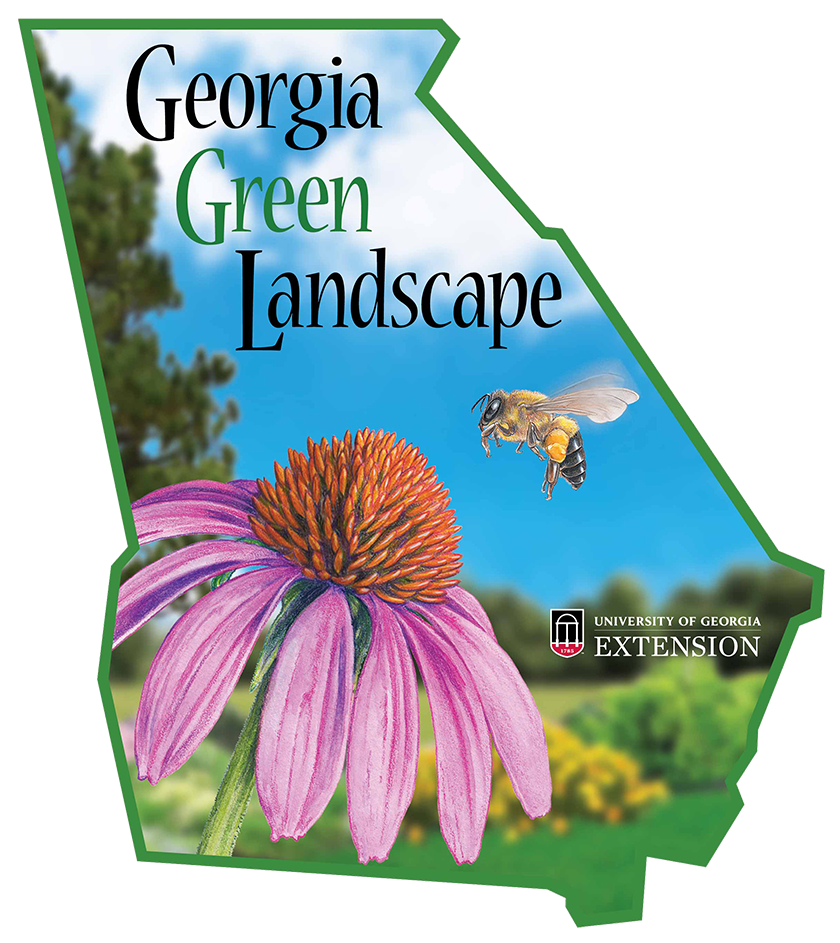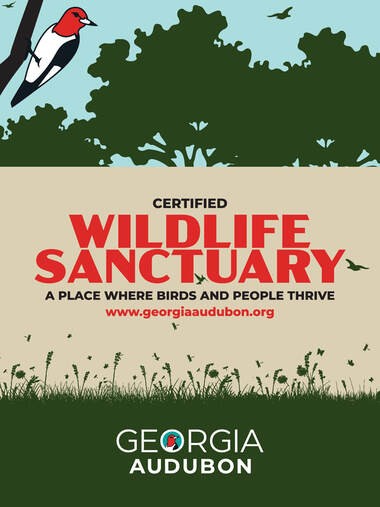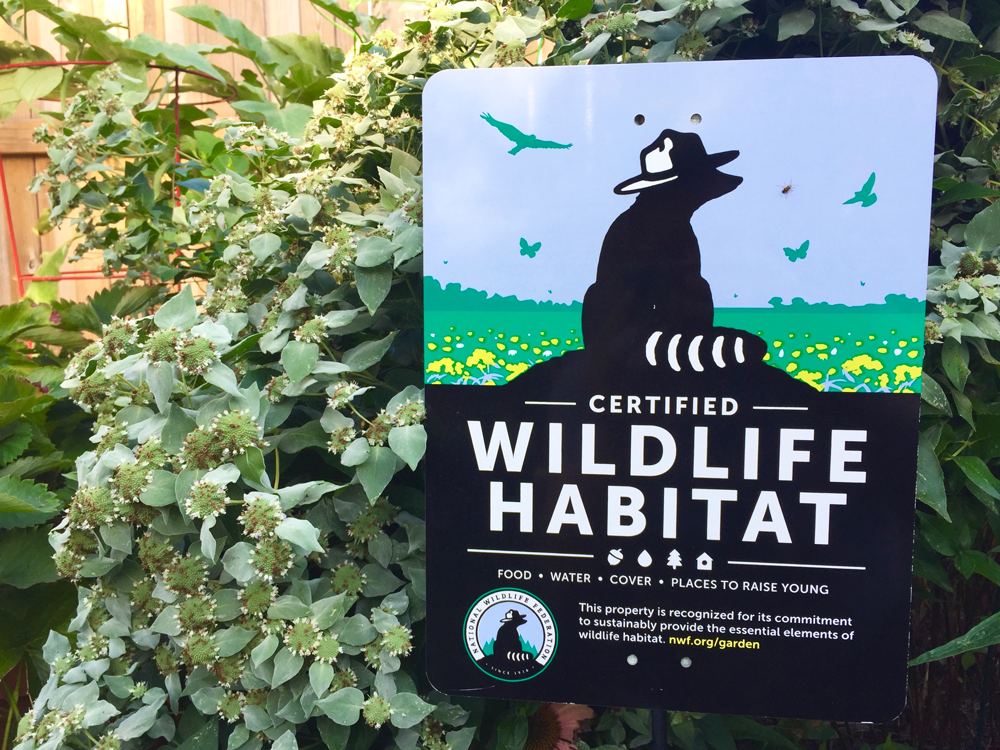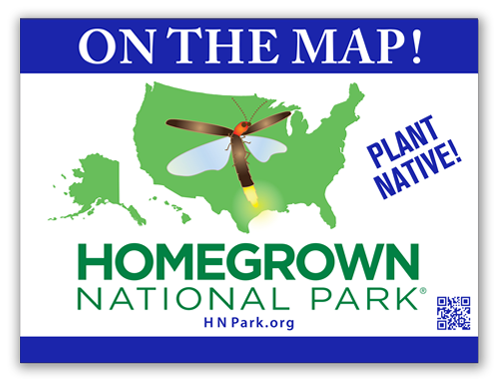Written by Pam Rentz, Fulton County Master Gardener Extension Volunteer
When a passerby stops and asks what that sign in your yard means, it’s an opening to have a conversation about any number of topics. Native plants, birds and butterflies and bees, wildlife, water, sustainable green landscape practices, invasive species and more are all topics that we can help and encourage others to learn more about to protect our world for generations to come.
But why go through the steps to certify your property and post a sign? It’s a way to show, not just tell. After all, we work to achieve certifications in our professional lives. Aren’t our landscapes important, too? Here’s an overview of a few sign certifications that signify that the location follows sustainable landscape practices.
Georgia Green Landscape

The Georgia Green Landscape Stewards Program, created by the University of Georgia Extension, was launched to inspire residences and businesses in Georgia to adopt more environmentally friendly practices and consider how their landscape use and activities can complement the natural world.
It takes just three simple steps to get certified:
#1 – Review the easy-to-access virtual learning tools and modules that provide information on:
- Composting
- Mulching
- Pollinator Habitats
- Welcoming Wildlife
- Water Conservation
- Water Quality
- Stormwater
- Invasive Species
- Native Plants
- Biodiversity
#2 – Check the Green Landscapes Metrics Scorecard to see if your landscape meets the minimum number of 70 points to gain “Certified Georgia Landscape” status.
For example, under Topic 4: Welcoming Wildlife, if you can check “Provide a food source with native plants: fruits, seed, forage, nectar, and pollen,” award yourself 4 points. Under Topic 9: Native Plants and Low Maintenance Landscapes, you can give yourself 4 points if you do the following: “Put the right plant in the right place! Consider sun, soil moisture, salt tolerance, spacing, and temperature. Plant in groups of three.” It’s not hard.
#3 – Send in your scorecard.
Email your completed scorecard to UGA’s Georgia Green Landscape Stewards coordinator at georgiagreen@uga.edu. You can also mail the scorecard to: Georgia Green Landscape Stewards,
Program Coordinator, UGA Extension Camden County, P.O. Box 309, Woodbine, GA 31569. You have the option to purchase an outdoor sign for your yard.
Georgia Audubon Wildlife Sanctuary

The Georgia Audubon Society encourages creating bird-friendly communities through conservation, education, and community engagement where wildlife and people thrive.
To certify your property as a Georgia Audubon Wildlife Sanctuary, your site must provide the basic components of a wildlife habitat: food, water, nesting and resting places.
The online Audubon Society Sanctuary Resources are excellent references for native plants, how to combat non-native, invasive species, how to create a haven for hummingbirds and much more.
National Wildlife Federation Certified Wildlife Habitat®

Since 1938, the National Wildlife Federation has provided conservation programs across the country, including the Ranger Rick magazine for children.
The National Wildlife Federation will recognize your site with a NWF Certified Wildlife Habitat® sign if you meet the following requirements for creating a wildlife habitat garden to attract birds, butterflies, and other neighborhood wildlife:
- Food: Native plants provide food eaten by a variety of wildlife. Feeders can supplement natural food sources.
- Water: All animals need water to survive, and some need it for bathing or breeding as well.
- Cover: Wildlife need places to take shelter from bad weather and places to hide from predators or hunt for prey.
- Places to Raise Young: Wildlife need resources to reproduce, and to protect and nourish their young.
- Sustainable Practices: Maintain your yard or garden in natural ways to ensure soil, air, and water stay healthy and clean.
Homegrown National Park

HOMEGROWN NATIONAL PARK® – Start a new HABITAT® is a conservation movement inspired by Doug Tallamy, a professor in the Department of Entomology and Wildlife Ecology at the University of Delaware, to plant native plants and remove most invasive plants.
From the website: Homegrown National Park™ is a term coined by Doug and is the key to our call-to-action:
“Our National Parks, no matter how grand in scale are too small and separated from one another to preserve species to the levels needed. Thus, the concept for Homegrown National Park, a bottom-up call-to-action to restore habitat where we live and work, and to a lesser extent where we farm and graze, extending national parks to our yards and communities.”
You can print a yard sign as well as get on the online map that shows individual contributions.